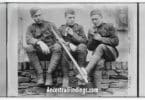When the gunpowder settled and the flags were folded, Revolutionary War soldiers had to return to lives that often looked nothing like the ones they’d left behind. For many veterans, survival during the war had been only half the battle. The other half was trying to get what was promised to them once peace had been declared.
That’s where the pension system came in — slowly, imperfectly, and full of red tape. But for family historians like us, those old paper trails can be a gift.
Promises Made, But Not Always Kept
Early on, veterans were often paid in promissory notes—essentially IOUs from the government. Some were never paid at all. Land was offered in exchange for service, but not everyone received it, and those who did sometimes struggled to claim or sell it.
By the early 1800s, the federal government finally began offering pensions, starting with those in financial need. Later, the eligibility was widened to include more veterans, widows, and children. These applications turned into thick folders of handwritten, personal documents that often tell more about your ancestor than their original service record ever could.
If your ancestor applied for a pension—or their spouse did after they passed—you may be in for a remarkable discovery.
What’s Inside a Revolutionary War Pension File?
A typical pension file might contain:
- A signed statement from the veteran about their military service
- Testimony from neighbors, fellow soldiers, or clergy
- Lists of children, sometimes with birth dates
- A copy of a marriage certificate or Bible record
- Property inventories showing just how little they owned
- Handwritten letters requesting aid, increases, or reinstatements
These aren’t just dry forms. They’re glimpses into your ancestor’s voice, their hardship, and the relationships that surrounded them in their later years.
Widows and the Fight for Recognition
It wasn’t just the soldiers who had to plead their case. Widows had their own long fight to be recognized. They had to prove not only that their husband served, but that they were legally married — and had been so before the dates required by the government’s ever-shifting pension laws.
If your ancestor’s widow applied for benefits, you might find:
- Statements from midwives or relatives confirming a wedding
- Family Bible entries showing births and marriages
- Descriptions of the veteran’s death, sometimes with emotional detail
- Affidavits from old neighbors or children
- And in some cases, their own handwritten summary of their life
These pension files often read like short autobiographies. They’re full of personal detail you won’t find anywhere else — especially valuable for family historians trying to add texture to a family story.
Where to Find These Records
Most Revolutionary War pension applications have been digitized and are easy to search with a few key resources:
- Fold3: Their Revolutionary War Pension Files collection includes thousands of digitized records. If you don’t have a subscription, your local library or FamilySearch center might.
- National Archives (NARA): If you’re after original copies or those not yet digitized, NARA holds the full records.
- FamilySearch: Offers selected pension indexes and occasionally full scans, especially when linked from a soldier’s profile.
- DAR Genealogical Research System: If your ancestor has a DAR-recognized service record, this system may link to pension applications or summaries.
Pro tip: Search with varied spellings of names. These records were handwritten, sometimes phonetically, and spelling wasn’t standardized. A last name like “Thompson” could appear as “Thomson,” “Tomson,” or even “Tompsin.”
Watch for Special Notes
As you browse the pension papers, keep an eye out for little surprises. You might find:
- A note saying “cannot write” beside an X-mark signature
- Descriptions of injuries or ailments that paint a vivid picture of their later years
- Mentions of a second marriage or additional children
- A neighbor’s name you recognize from your tree, hinting at extended family
These small clues often lead to much larger discoveries. You might even uncover connections to other branches of your tree, or neighboring families that intermarried with yours over generations.
Not Everyone Qualified
One hard truth is that many veterans never got their pensions. Some missed deadlines. Others couldn’t prove their service, especially if their records were lost or if they served in a local militia not officially recognized.
Still, even a rejected pension file can contain rich biographical material.
And if your ancestor didn’t apply? Try checking for widows or children who may have applied later. Many pensions weren’t granted until decades after the war ended. Some widows filed into the 1850s and 1860s — by then, their husbands had been gone for decades, but the memory of their service still lived on in the paperwork.
A Record of Struggle, Survival, and Strength
The pension system was a bureaucratic mess, but what it left behind is a paper trail of humanity. These files are more than names and dates — they’re pieces of real lives lived in hardship, resilience, and hope.
If you’re lucky enough to have a Revolutionary War veteran in your family tree, take the time to track down their pension records. Read them slowly. Absorb the words. Imagine them sitting by a fireplace in old age, recounting what they did in their youth, asking for a little help to finish out their life.
They weren’t just soldiers.
They were husbands, fathers, neighbors, and survivors.
And they left us something more lasting than medals. They left us their story — one petition at a time.






